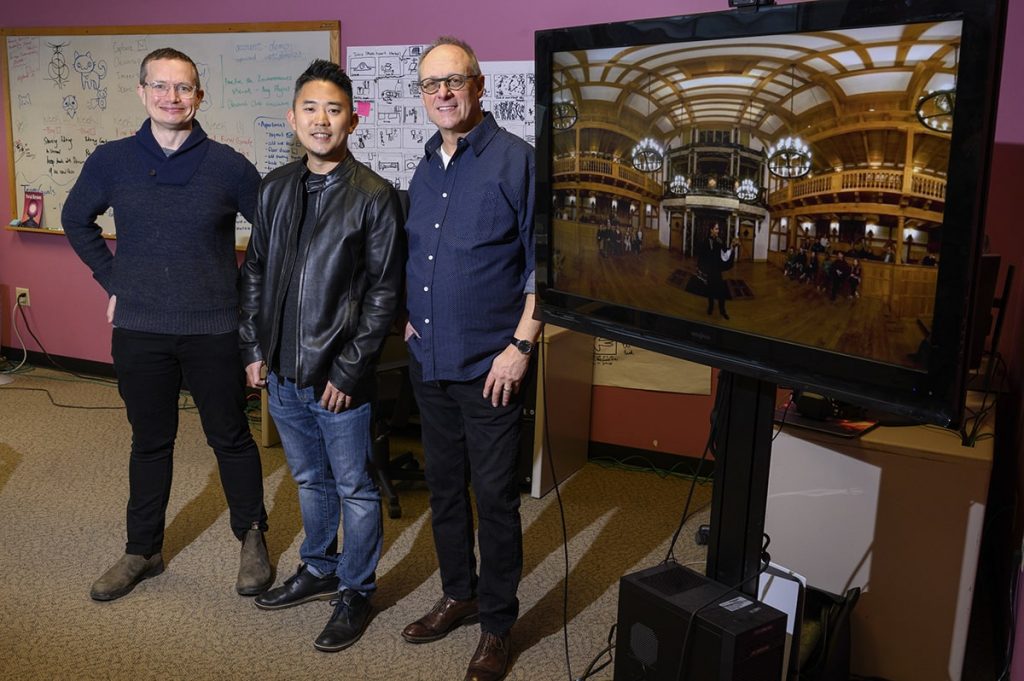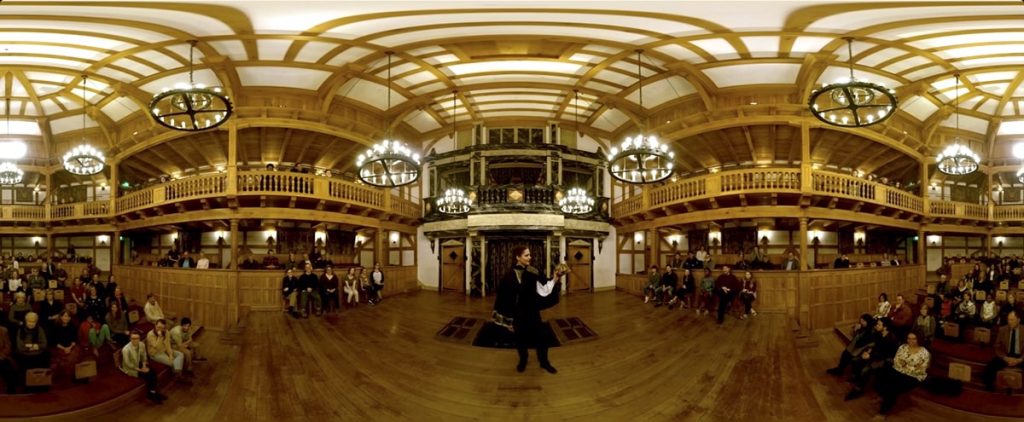2024 Post Graduation Statistics
Post graduation results of ETC students who completed degree requirements in May 2024.
This article was featured on CMU’s news site and written by Stefanie Johndrow and was edited for the ETC site. Original article: https://www.cmu.edu/news/stories/archives/2022/april/humanities-grants.html?fbclid=IwAR2Lm8L2BhF3aXlDcX6Ah5H5v3hfR30pUrsq9njoNI5vT3rrszquiq8MHYU
The study of the human experience, which is at the core of a humanities education, is being transformed by the emergence of big data, computational thinking and virtual reality. Two Carnegie Mellon University projects that use technology as a tool for uncovering lessons about our history and culture have received grants from the National Endowment for the Humanities. Stephen Wittek, an assistant professor of English, received a $100,000 prototyping grant for Shakespeare-VR.
Shakespeare-VR, which launched in 2019, uses virtual reality technologies to bring students face-to-face with professional actors performing Shakespeare in venues like the Globe and Blackfriars theatres.
“Shakespeare has this enormous footprint in our culture. He’s by far the most celebrated author in the Western canon and probably in the history of human letters,” Wittek said. “There are statues of Shakespeare in parks around the world. Whether you realize it or not, you probably hear references and quotes from Shakespeare every time you pick up a newspaper or watch television. His works are performed in thousands of iterations every single year.”
Through the grant, Wittek and his team will hire real actors and film their performances of “Hamlet,” “Macbeth” and “Romeo and Juliet.” Those filmed performances will become the basis for a 3D reconstruction, not a 2D image, that users see when they go into virtual reality. The VR technologies are designed by Jaehee Cho (16), a graduate of the Entertainment Technology Center, and Ralph Vituccio, a teaching professor in the ETC, and aim to approximate the existing feeling of performing.

“The number one way to understand Shakespeare is to attend a live performance. It is really essential to try to get students outside of the classroom and get the real feel,” Wittek said. “VR provides the next best experience. Unfortunately, going to the theater is something that is not doable for a lot of people.”
After a 2018 visit to the Blackfriars Theater in Staunton, Virginia, Vituccio saw the potential of placing a user in a Shakespeare play and giving them the ability to interact with other characters. Through Shakespeare-VR and his own VR productions, Vituccio has witnessed what VR can add to the learning experience.
“I believe certain serious immersive VR interactions can be used to induce empathetic reactions aimed at social change. It’s somewhat like allowing users to ‘walk in someone else’s shoes’ and experience life through another’s eyes,” Vituccio said. “By allowing users to play a part in a Shakespeare play, interacting, and talking with other characters, I believe will be a transformational experience. By fostering a deeper understanding of the power, depth and longevity of Shakespeare’s phrases and sonnets, the interactive Shakespeare will be a game changer in theater academics, training actors, entertainment, and bringing the Bard’s influence to light for many more to appreciate.”
While there are other adaptations of bringing Shakespeare into virtual reality, Wittek’s Shakespeare-VR is free to use and aimed toward education and providing a historical perspective and context. With a VR headset on, students are able to watch Shakespearean scenes or act out parts themselves, having full control of the stage.

“I hope Shakespeare-VR will help to introduce students to theatrical history, that it will help to enforce a sense that this literature isn’t just poetry, that it is drama and comes alive in the theater. Although Shakespeare is also aware of his reading audience, I think the primary audience that he has in mind will be the theatrical audience,” Wittek said. “In a way, just reading the script of a play is kind of like reading a recipe without ever getting to taste the cake. I think a project like Shakespeare-VR helps give students a sense of what the cake actually tastes like.”
Sarah Enloe, director of education at the American Shakespeare Center, said virtual reality like Shakespeare-VR will change the way students learn about the writer and his works.
“I cannot proclaim loudly enough how wonderful virtual reality can be for pedagogical practice,” Enloe said. “Your students will experience Shakespeare in a community, as Shakespeare imagined it be, and they will see that there is opportunity for an actor to direct something to an audience member. That’s very difficult to describe in a classroom, but when you see it happen on screen, you finally understand that all those question marks and all of those long speeches and everything that your students are wrestling with is there for a reason. It’s there because the audience is part of the play.”
Post graduation results of ETC students who completed degree requirements in May 2024.
Student handbook for the ETC class that started August 26 2024
Post graduation results of ETC students who completed degree requirements in May 2023.
Student handbook for the ETC class that started August 28 2023.
Post graduation results of ETC students who completed degree requirements in December 2021 and May 2022
Post graduation results of ETC students who completed degree requirements in December 2020 and may 2021
View Carnegie Mellon's Brand Guidelines
Carnegie Mellon University does not discriminate in admission, employment, or administration of its programs or activities on the basis of race, color, national origin, sex, handicap or disability, age, sexual orientation, gender identity, religion, creed, ancestry, belief, veteran status, or genetic information. Furthermore, Carnegie Mellon University does not discriminate and is required not to discriminate in violation of federal, state, or local laws or executive orders.
Inquiries concerning the application of and compliance with this statement should be directed to the university ombudsman, Carnegie Mellon University, 5000 Forbes Avenue, Pittsburgh, PA 15213, telephone 412-268-1018.
Obtain general information about Carnegie Mellon University by calling 412-268-2000.